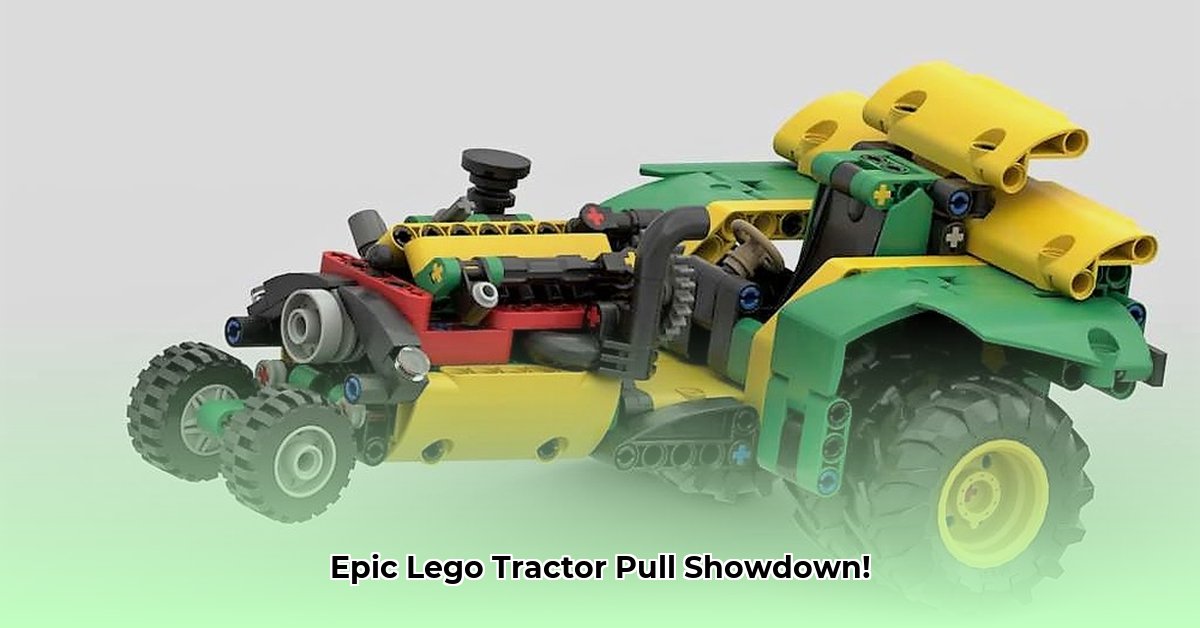
Want to build a Lego tractor tough enough for a real-life pulling contest? This article compares two distinct Lego tractor designs—one a powerhouse from YouTube, the other a versatile champion from Rebrickable—exploring their strengths, weaknesses, and the engineering principles behind them. Whether you're a seasoned Lego builder, an engineering student, or simply curious, we'll help you understand what makes these miniature marvels tick. For more on tractor pulling contests, see this helpful guide.
The YouTube Behemoth: Power and Complexity
Imagine a tiny Lego V6 engine, driving a dual-motor setup: one for locomotion, the other simulating the powerful roar of a real tractor. This YouTube design is a pulling powerhouse, capable of dragging surprisingly heavy weights. It's a testament to skilled Lego Technic building, a true demonstration of functional engineering.
However, this raw power comes at a cost. Detailed building instructions are absent. This makes recreating the design a significant challenge. It's a complex, high-performance machine, less suited for casual builders and more for those comfortable wrestling with intricate Technic mechanisms. Think of it as a supercharged race car: impressive, but not ideal for everyday farm work.
- Core Strength: Unmatched pulling power.
- Key Weakness: Extremely challenging to replicate due to a lack of available instructions.
- Target Audience: Experienced Lego Technic builders.
The Rebrickable Wonder: Versatility and Adaptability
The Rebrickable design offers a refreshing contrast. Forget brute force; this tractor focuses on adaptability. Features like an adjustable sled track and a raiseable front end highlight its versatility. Want to add a weight winch? Go for it! This design is about playability and customizability.
While it might not match the YouTube design's pulling strength, its adaptability is a significant advantage. It's more like a dependable pickup truck – reliable and ready for various tasks. This makes it ideal for experimentation and modification. Clear instructions are readily available, making it accessible to a wider range of builders.
- Core Strength: High adaptability and customizability. Clear building instructions included.
- Key Weakness: Moderate pulling power compared to the YouTube design.
- Target Audience: Builders of all skill levels, especially those who enjoy customizing their builds.
Head-to-Head Comparison: Power vs. Playability
This table summarizes the key differences between the two designs:
| Feature | YouTube Design | Rebrickable Design |
|---|---|---|
| Pulling Power | Very High | Moderate |
| Adaptability | Low | High |
| Build Difficulty | High (lack of instructions) | Moderate (instructions provided) |
| Overall Complexity | High | Moderate |
Think of the YouTube design as a Formula 1 race car—powerful but demanding, while the Rebrickable design is a sturdy pickup truck, reliable and versatile. Which one is "better" depends entirely on your priorities.
"The choice between these two designs underscores a fundamental principle in engineering: optimization," says Dr. Anya Sharma, Professor of Mechanical Engineering at MIT. "Each design prioritizes a different set of performance characteristics – power versus versatility."
Choosing Your Champion: A Practical Guide
Do you crave the challenge of building a powerful, albeit complex, Lego tractor? If so, the YouTube creation is your calling. However, if you prioritize versatility and a straightforward build experience, the Rebrickable design is the clear winner. Both offer invaluable learning experiences regarding engineering principles and Lego Technic techniques.
How to Build Your Own Lego Tractor Pulling Mechanism: Three Pivotal Steps
Choose Your Design: Carefully consider your skill level and desired outcome. The YouTube design offers immense pulling power but necessitates advanced building skills due to the lack of accessible instructions. The Rebrickable option offers a more manageable challenge and superior customizability.
Gather Your Parts: Using the instructions provided (for the Rebrickable design), or through careful observation of the YouTube model's videos, source the necessary Lego Technic parts. Remember, both models often utilize parts from the 42136 John Deere set, showcasing imaginative repurposing.
Build and Test: Follow the instructions (where available) meticulously. For the YouTube design, expect to resolve issues through problem-solving and careful observation. Testing your creation with varying weights will provide valuable insights into its performance and potential modifications.
With careful planning and execution, you can construct a remarkable Lego tractor pulling mechanism, regardless of which design you select. The experience will be both rewarding and educational, teaching valuable lessons about engineering principles and the boundless creativity within the Lego Technic system.